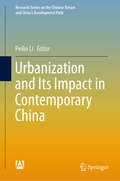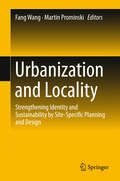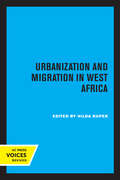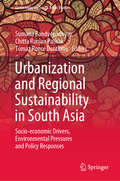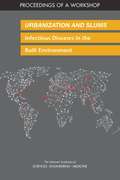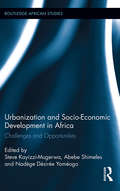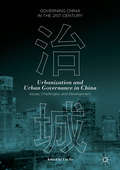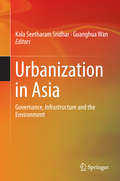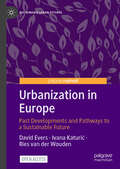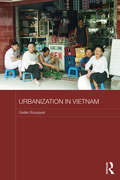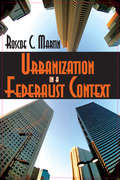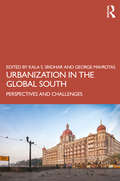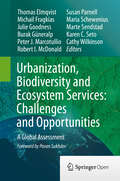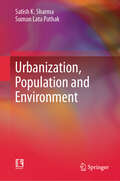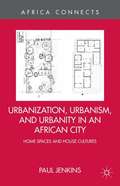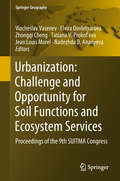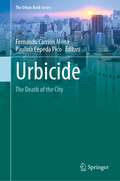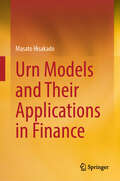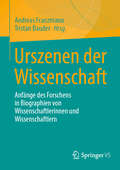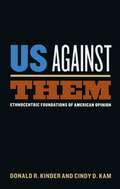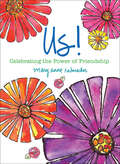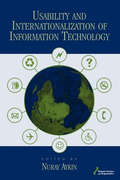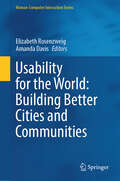- Table View
- List View
Urbanization and Its Impact in Contemporary China (Research Series on the Chinese Dream and China’s Development Path)
by Peilin LiThis book addresses a wide range of social issues in connection with urbanization, which is providing new momentum for China’s economic restructuring and social progress, including the educational gap; the middle class in urbanization; consumption; division of labor; and social integration. All chapters are based on updated nation-wide sampling survey data. Taken together, they provide a lens for understanding various aspects of urbanization and its impacts on China’s economy and society.
Urbanization and Locality
by Fang Wang Martin ProminskiBased on a discussion of conflicts in the urbanization process, this book provides theoretical and practical solutions for the preservation and development of urban localities. On the basis of informative case studies, it reveals the similarities and unique aspects of urbanization in Germany and China. The process of urban growth and the future trend of locality and urbanization are also examined. The book gathers contributions from architects, landscape designers, environmental engineers, urban planners and geographers, who analyze urban issues from their individual perspectives and provide methods for preserving and developing urban localities. As such, it expresses responses to urban development trends against the backdrop of sustainability in the 21st century.
Urbanization and Migration in West Africa
by Hilda KuperThis title is part of UC Press's Voices Revived program, which commemorates University of California Press’s mission to seek out and cultivate the brightest minds and give them voice, reach, and impact. Drawing on a backlist dating to 1893, Voices Revived makes high-quality, peer-reviewed scholarship accessible once again using print-on-demand technology. This title was originally published in 1965.
Urbanization and Regional Sustainability in South Asia: Socio-economic Drivers, Environmental Pressures and Policy Responses (Contemporary South Asian Studies)
by Sumana Bandyopadhyay Chitta Ranjan Pathak Tomaz Ponce DentinhoThis book examines urbanization and migration processes in South Asia. By analyzing the socio-economic impacts and infrastructural, environmental and institutional aspects of different conurbations, it highlights conflicts over agricultural land as well as the effects on health, education, poverty and the welfare of children, women and old people. The authors also explore issues of mobility; connectivity and accessibility of public services, and discuss the effective use of new urban-management tools, such as the concept of smart cities and urban spatial monitoring.
Urbanization and Slums: Infectious Diseases In The Built Environment: Proceedings Of A Workshop
by Engineering Medicine National Academies of SciencesThe urban built environment is a prime setting for microbial transmission, because just as cities serve as hubs for migration and international travel, components of the urban built environment serve as hubs that drive the transmission of infectious disease pathogens. The risk of infectious diseases for many people living in slums is further compounded by their poverty and their surrounding physical and social environment, which is often overcrowded, is prone to physical hazards, and lacks adequate or secure housing and basic infrastructure, including water, sanitation, or hygiene services. To examine the role of the urban built environment in the emergence and reemergence of infectious diseases that affect human health, the National Academies of Sciences, Engineering, and Medicine planned a public workshop. This publication summarizes the presentations and discussions from the workshop.
Urbanization and Socio-Economic Development in Africa: Challenges and Opportunities (Routledge African Studies #16)
by Abebe Shimeles Steve Kayizzi-Mugerwa Nadège Désirée YaméogoThe main goal of this book is to put urbanization and its challenges squarely on Africa’s development agenda. Planned urbanization can improve living conditions for the majority, help in the expansion of the middle class, and create conditions for economic transformation. However, many African cities have developed haphazardly, resulting in the decline of public services, in slum proliferation, and increases in poverty. African cities thrive on activities characterized by easy entry and low productivity, generally referred to as the "informal sector". Indeed, today some urban dwellers are poorer than their cousins in the countryside. In spite of reform attempts, many governments have not been able to create an enabling environment, with adequate infrastructure and institutions to sustain markets for easy exchange and production. This study argues that with careful policies and planning, the situation can be changed. If the recent natural resource-led economic boom that we have seen in many African countries is used for structural reforms and urban renewal, African cities could become centers of economic opportunity. The challenge for African policymakers is to ensure that urban development is orderly and that the process is inclusive and emphasizes the protection of the environment, hence green growth.
Urbanization and Urban Governance in China
by Lin YeThis book explores the process of urbanization and the profound challenges to China's urban governance. Economic productivity continues to rise, with increasingly uneven distribution of prosperity and accumulation of wealth. The emergence of individual autonomy including demands for more freedom and participation in the governing process has asked for a change of the traditional top-down control system. The vertical devolution between the central and local states and horizontal competition among local governments produced an uneasy political dynamics in Chinese cities. Many existing publications analyze the urban transformation in China but few focuses on the governance challenges. It is critical to investigate China's urbanization, paying special attention to its challenges to urban governance. This edited volume fills this gap by organizing ten chapters of distinctive urban development and governance issues.
Urbanization in Asia
by Guanghua Wan Kala Seetharam SridharThis work focuses on urban governance in the developing world, its aim being to bring a holistic perspective to the debate on urban governance in Asia and around the globe. It has been divided into three sections: The first section is on rural interventions as they influence urbanization and its problems/solutions. The second focuses on urban governance, infrastructure programs, service delivery reforms and their evaluation. The third and final section focuses on urbanization and the environment. In the first section, we present evaluations of India's rural programs including the Mahatma Gandhi National Rural Employment Guarantee Act (MGNREGA), and of India's Total Sanitation Campaign. This section covers the transition from rural to urban areas, and highlights coping mechanisms in urban areas and policy implications for urban governance, from the viewpoint of rural migrants. The section on urban governance, infrastructure and service delivery is the most in-depth and consists of papers that present state-of-the-art research on many aspects of infrastructure such as cost and time overruns, risks and their mitigation, assessments of the metro rail, and services such as solid waste management. The focus of the final section is on urbanization and the environment. Here we examine land use change in India, the relationship between urban form and residential energy use in Bandung, Indonesia, and end by depicting a cautiously optimistic view of Asia's urbanization-environment nexus.
Urbanization in Europe: Past Developments and Pathways to a Sustainable Future (Sustainable Urban Futures)
by David Evers Ivana Katurić Ries van der WoudenThis open access book comes at an opportune time, with ‘land take’ high on the EU policy agenda. It shows how over one million hectares in Europe became urbanized between 2000 and 2018, over eight times that which changed back to agriculture or nature. This book seeks to explain this development and offer suggestions on how to control it, drawing on the ESPON Sustainable Urbanization and land-use Practices in European Regions (SUPER) project. It presents up-to-date analyses on urbanization rates (land take) as well as densities and morphology (sprawl). It also discusses the impact of spatial planning instruments and other public-sector interventions. Finally, the book peers into the future by drawing up urbanization scenarios – compact, polycentric, and diffuse – for 2050, and reflects on their sustainability. It concludes with the encouraging message that policy can make a positive difference.
Urbanization in Vietnam (Routledge Contemporary Southeast Asia Series)
by Gisele BousquetMost studies on urbanisation focus on the move of rural people to cities and the impact this has, both on the cities to which the people have moved, and on the rural communities they have left. This book, on the other hand, considers the impact on rural communities of the physical expansion of cities. Based on extensive original research over a long period in one settlement, a rural commune which over the course of the last two decades has become engulfed by Hanoi’s urban spread, the book explores what happens when village people become urbanites or city dwellers – when agriculture is abandoned, population density rises, the value of land increases, people have to make a living in the city, and the dynamics of family life, including gender relations, are profoundly altered. This book charts these developments over time, and sets urbanisation in Vietnam in the wider context of urbanisation in Southeast Asia and Asia more generally.
Urbanization in a Federalist Context
by Roscoe MartinThe emergence of America as a metropolitan-urban society has had profound consequences for every phase of national life, but nowhere has its effects been greater than in the domain of government. The growth of the city and its evolution into the metro-city has led to problems more complex and intense than any previously known. These problems command the concern and resources of all governments, federal as well as state and local; for as they have gained general attention they have emerged as national problems.Coincident with national involvement in problems once held to be local has come a rise in federal government relations with the cities. Such relations, though in fact of long standing, have increased greatly in number and intensity since 1933. The result is a significant expansion in the practice of federalism, one marked by the emergence of the cities as partners in the federal system. Urbanization in a Federalist Context treats the expanded federal partnership in urban growth and argues that it is not a fact to be welcomed.Martin traces the expansion of federal authority in the United States from the 1930s through the 1960s. He shows how local issues become national issues, and also how national authority expands, affecting all aspects of location government. The developments he explores reflect a federal system in the process of constant but evolutionary growth. Martin reveals why the relationship between the federal system and metro-cities is a flexible arrangement, capable of adjusting to new demands-but not without its own risks. This classic will be of continuing interest to those concerned about the consequences of the expansion of government authority in the United States.
Urbanization in the Global South: Perspectives and Challenges
by Kala S. Sridhar and George MavrotasThis book examines the challenges of urbanization in the global south and the linkages between urbanization, economic development and urban poverty from the perspectives of cities in Asia, Africa and Latin America. It focuses on various aspects of urbanization ranging from food security and public services like sanitation, water and electricity to the finances of cities and externalities associated with the urbanization process. The volume also highlights the importance of participatory urban governance for cities in India with comparative perspectives from other countries. It further focuses on the urbanization of poverty, livelihood in urban areas, overconsumption and nutrition and ecology. Based on primary data, the chapters in the volume review trends, opportunities, challenges, governance and strategies of several countries at different levels of urbanization, with several case studies from India. This multidisciplinary volume will be of great interest to researchers and students of development studies, sociology, economics and urban planning and policy. It will also be useful for policymakers, think tanks and practitioners in the area of urbanization.
Urbanization, Biodiversity and Ecosystem Services: Challenges and Opportunities
by Robert I. Mcdonald Michail Fragkias Burak Güneralp Thomas Elmqvist Julie Goodness Peter J. Marcotullio Susan Parnell Maria Schewenius Marte Sendstad Karen C. Seto Cathy WilkinsonUrbanization is a global phenomenon and the book emphasizes that this is not just a social-technological process. It is also a social-ecological process where cities are places for nature, and where cities also are dependent on, and have impacts on, the biosphere at different scales from local to global. The book is a global assessment and delivers four main conclusions: Urban areas are expanding faster than urban populations. Half the increase in urban land across the world over the next 20 years will occur in Asia, with the most extensive change expected to take place in India and China Urban areas modify their local and regional climate through the urban heat island effect and by altering precipitation patterns, which together will have significant impacts on net primary production, ecosystem health, and biodiversity Urban expansion will heavily draw on natural resources, including water, on a global scale, and will often consume prime agricultural land, with knock-on effects on biodiversity and ecosystem services elsewhere Future urban expansion will often occur in areas where the capacity for formal governance is restricted, which will constrain the protection of biodiversity and management of ecosystem services
Urbanization, Population and Environment
by Satish K. Sharma Suman Lata PathakThe volume explores the intricate relationship between urbanization, population dynamics, and the environment in the western Himalayas from a historical perspective. It challenges the conventional link that urban development is solely tied to population growth, unveiling the influence of political and economic elites. Through empirical analysis within a historical context, the study unveils the significance of cantonment towns, military consolidation, and legislative control in driving urban growth. While it leads to population surges, economic activities, and improvements in transportation and communication, it also exposes adverse effects like the overuse of forest resources, disrupting the balance between humans and nature, and leading to ecological imbalances and fatalities. This volume opens new avenues for research on rivers, biodiversity, geopolitics, socio-cultural aspects, and the economy but also offers valuable insights for national and international academia.
Urbanization, Urbanism, And Urbanity In An African City
by Paul JenkinsUrbanization in sub-Saharan Africa has historic roots, and though it has accelerated in recent decades, it retains distinctive forms. This book explores sub-Saharan urbanism through a detailed and wide-ranging study of Maputo, Mozambique, covering physical and socio-economic factors as well as an ethnographic inquiry into cultural attitudes.
Urbanization: Proceedings Of The 9th Suitma Congress (Springer Geography)
by Jean Louis Morel Elvira Dovletyarova Viacheslav Vasenev Zhongqi Cheng Tatiana V. Prokof’eva Nadezhda D. AnanyevaThis proceedings volume focuses on different aspects of environmental assessment, monitoring, and management of urban and technogenic soils. Soils of Urban, Industrial, Traffic, Mining and Military Areas (SUITMAs) differ substantially from their natural zonal counterparts in their physical, chemical and biological features, their performed functions, and supported services.This book discusses the monitoring, analysis and assessment of the effects of urbanization on soil functions and services. Further, it helps to find solutions to the environmental consequences of urbanization and discusses best management practices such as management and design of urban green infrastructure, waste management, water purification, and reclamation and remediation of contaminated soils in the context of sustainable urban development.The book includes thematic sections corresponding to 14 sessions of the SUITMA 9 congress, covering broad topics that highlight the importance of urban soils for society and environment and summarizing the lessons learned and existing methodologies in analyses, assessments, and modeling of anthropogenic effects on soils and the related ecological risks.This proceedings book appeals to scientists and students as well as practitioners in soil and environmental science, urban planning, geography and related disciplines, and provides useful information for policy makers and other stakeholders working in urban management and greenery.
Urbicide: The Death of the City (The Urban Book Series)
by Fernando Carrión Mena Paulina Cepeda PicoThis book uses the reflection of academics specialized in the urban area of Latin America, Europe and the United States, to initiate a comparative debate of the different dynamics in which Urbicidio expresses itself. The field or focal point of analysis that this publication approaches is the city, but under a new critical perspective of inverse methodology to that has been traditional used. It is about understanding the structural causes of self-destruction to finally thinking better and then going from pessimism to optimism.It is a deep look at the city from an unconventional entrance, because it is about knowing and analyzing what the city loses by the action deployed by own urbanites, both in the field of its production and in the field of its consumption. This suppose that the city does not have an ascending linear sequential evolution in its development but neither in each of its parts in the improvement process, showing the face that commonly not seen but others live. The category used for this purpose is that of Urbicidio or the death of the city, which contributes theoretically and methodologically to the knowledge of the city, as well as to the design of urban policies that neutralize it. In addition, it is worth mentioning that the book has an inclusive view of the authors. For this reason, gender parity, territorial representation and the presence of age groups have been sought.
Urn Models and Their Applications in Finance
by Masato HisakadoThis fascinating book begins with fundamental definitions and notations of urn models before moving on to stochastic processes and applications of urn models in the field of finance. The Pólya urn model is simple but has rich content and diverse applications because it includes correlations. Applications of Pólya models such as phase transitions in nonlinear Pólya models are studied here, and the relation between temporal correlation and phase transition is also discussed. In a continuous limit, the self-exciting negative binomial distribution model and Hawkes model, which has Poisson noise, can be obtained. In these models, it is possible to observe phase transition as a branching process, which is one of the absorption phase transitions. If connected urns are considered, the process can be extended to represent correlations between several urns, corresponding to complex networks among the urns and leading to consideration of how the network affects the urn processes. In this book, the method is applied to default portfolios, including correlations. In finance, correlation is an important issue in the clustering of a default, and several topics involving applications of urn models to risk assessment for default portfolios in finance are explained. Especially in default portfolios, some sectors affect many other sectors while other sectors do not; thus the origin of default contagion, a phenomenon to which urn models with networks are applied here.
Ursachen des Fachkräftemangels im beruflichen Lehramt: Die Attraktivität des Studiums aus der Sicht von Studierenden (BestMasters)
by Joana Sophie KoldehoffDas berufliche Lehramt verzeichnet bereits seit vielen Jahren einen deutlichen Fachkräftemangel, der sich auch in den niedrigen Studierendenzahlen an den Universitäten widerspiegelt. Es gibt bereits einige Studien, die sich mit der Ursachenforschung sowie Maßnahmenfindung zur Behebung des Fachkräftemangels beschäftigt haben. Anschließend daran wird im Rahmen dieser Analyse eine Umfrage mit Studierenden des beruflichen Lehramts durchgeführt, um deren Wahrnehmung der Attraktiviät des Studiums zu erfassen. Außerdem werden mögliche Kritikpunkte aufgegriffen, die von Studierenden geäußert werden und gegebenenfalls für andere Studieninteressierte Ausschlusskriterien darstellen und somit die niedrigen Studierendenzahlen begünstigen. Der Schwerpunkt liegt dabei auf den externen Einflussfaktoren, während die individuellen Berufswahlmotive der Studierenden nicht im Fokus der Untersuchungen stehen.
Urszenen der Wissenschaft: Anfänge des Forschens in Biographien von Wissenschaftlerinnen und Wissenschaftlern
by Andreas Franzmann Tristan BauderWelche Bildungsprozesse in Kindheit und Jugend bereiten eine spätere Berufslaufbahn in den Wissenschaften vor? Warum ergreifen Menschen den Forscherberuf? Und wie weit lassen sich ihre persönlichen Forschungsthemen lebensgeschichtlich zurückverfolgen? Anhand exemplarischer Fallstudien zu Lebensläufen von Forscherinnen und Forschern aus den Natur-, Geistes- und Sozialwissenschaften rekonstruiert der Band die Anfänge wissenschaftlicher Bildungsbiographien, wie sie sich aus autobiographischen Texten und Interviews erschließen lassen. Erste erinnerbare Begegnungen mit einem späteren Thema der Forschung, Szenen aus Schule und Peer Group, Selbstaktivitäten des Sammelns, Grabens, Erkundens, Diskutierens. Die Studien machen sichtbar, dass sich eine biographische Disposition zum Beruf der Wissenschaft oft schon früh herausbildet, wenn auch viele Umwege gegangen werden müssen. Diese Disposition scheint immer getragen von einer individuellen Faszination für Gegenstände und Phänomene, Rätsel und Methoden ihrer Erschließung, deren Entstehung selbst biographisch rätselhaft ist. Auch wenn ein professionalisierter Habitus sich erst zwischen Studium und Postdoc-Phase bildet, bereitet er sich in den informellen Bildungsprozessen und außer-institutionellen Aktivitäten vor und hat hier eine persönliche Verwurzelung, die sich auch im späteren akademischen Betrieb immer wieder erneuern muss.
Us Against Them: Ethnocentric Foundations of American Opinion
by Donald R. Kinder Cindy D. KamEthnocentrism--our tendency to partition the human world into in-groups and out-groups--pervades societies around the world. Surprisingly, though, few scholars have explored its role in political life. Donald Kinder and Cindy Kam fill this gap with Us Against Them, their definitive explanation of how ethnocentrism shapes American public opinion. Arguing that humans are broadly predisposed to ethnocentrism, Kinder and Kam explore its impact on our attitudes toward an array of issues, including the war on terror, humanitarian assistance, immigration, the sanctity of marriage, and the reform of social programs. The authors ground their study in previous theories from a wide range of disciplines, establishing a new framework for understanding what ethnocentrism is and how it becomes politically consequential. They also marshal a vast trove of survey evidence to identify the conditions under which ethnocentrism shapes public opinion While ethnocentrism is widespread in the United States, the authors demonstrate that its political relevance depends on circumstance. Exploring the implications of these findings for political knowledge, cosmopolitanism, and societies outside the United States, Kinder and Kam add a new dimension to our understanding of how democracy functions.
Us!: Celebrating the Power of Friendship
by Mary Anne RadmacherFrom the “Martha Stewart of inspired living” comes a book full of inspirational quotes and words of encouragement to help you appreciate your friends.Friends build us up. They make us stronger, smarter, and better. In this delightful, beautifully illustrated gift book; writer, artist, and friend extraordinaire Mary Anne Radmacher shares the many ways we celebrate each other.Discover the special talent that Radmacher has to change lives with her words. Read this extraordinarily touching book which includes an abundance of:Motivational quotesPoetryAphorisms about the importance of friendshipThe perfect gift for friends or yourself. With original four-color lettering, art and design, Mary Anne offers a funny, sweet, and perfect book for any occasion. “When we have a circle of friends, we have more fun. We get more done, we feel and are stronger, and we really do celebrate the power of our ‘us,’” says Mary Anne Radmacher.
Us, Them, and Others
by Elke WinterHow do countries come to view themselves as being 'multicultural'? Us, Them, and Others presents a dynamic new model for understanding pluralism based on the triangular relationship between three groups -- the national majority, historically recognized minorities, and diverse immigrant bodies. Elke Winter's research illustrates how compromise between unequal groups is rendered meaningful through confrontation with real or imagined outsiders.Us, Them, and Others sheds new light on the astonishing resilience of Canadian multiculturalism in the late 1990s, when multicultural policies in other countries had already come under heavy attack. Winter draws on analyses of English-language newspaper discourses and a sociological framework to connect discourses of pan-Canadian multicultural identity to representations of Quebecois nationalism, immigrant groups, First Nations, and the United States. Taking inspiration from the Canadian experience, Us, Them, and Others is an enticing examination of national identity and pluralist group formation in diverse societies.
Usability and Internationalization of Information Technology (Human Factors and Ergonomics)
by Nuray AykinToday, more and more Web sites are providing content in multiple languages for targeted countries, and more and more products are being designed for cultural differences in mind. However, the concept of cross-cultural design has not yet become a strong force in the practitioners' and educators' agenda. This book looks at techniques, software, tools
Usability for the World: Building Better Cities and Communities (Human–Computer Interaction Series)
by Amanda Davis Elizabeth RosenzweigWant to build cities that truly work for everyone? Usability for the World: Sustainable Cities and Communities reveals how human-centered design is key to thriving, equitable urban spaces. This isn't just another urban planning book; it's a practical guide to transforming cities, offering concrete strategies and real-world examples you can use today. What if our cities could be both efficient and human-friendly? This book tackles the core challenge of modern urban development: balancing functionality with the well-being of residents. It explores the crucial connection between usability and sustainability, demonstrating how design principles, from Universal to life-centered, create truly livable cities. Interested in sustainable urban development? Usability for the World offers a global perspective, showcasing diverse approaches to creating equitable and resilient cities. Through compelling case studies, discover how user-centered design addresses pressing urban challenges. See how these principles connect directly to achieving the UN Sustainable Development Goals, specifically SDG 11: Sustainable Cities and Communities. This book offers more than theory. It provides practical insights and actionable strategies for: Designing user-centered cities: Apply usability principles to urban planning. Improving urban spaces: Discover how tech and innovation create human-friendly environments. Building sustainable communities: Explore the link between human-centered design and the SDGs. Creating equitable cities: Understand how design promotes inclusivity and accessibility. Whether you're an urban planner, designer, policymaker, or simply someone who cares about our cities' future, Usability for the World provides the tools and inspiration you need. Join the movement to build better cities, one human-centered design at a time. What will your contribution be to the future of urban living?
